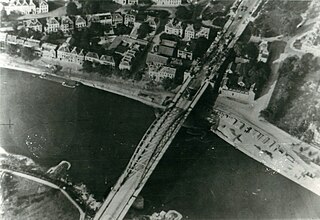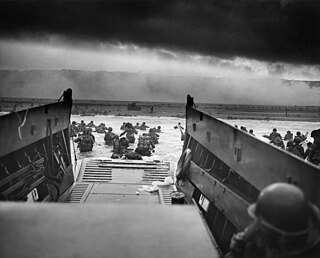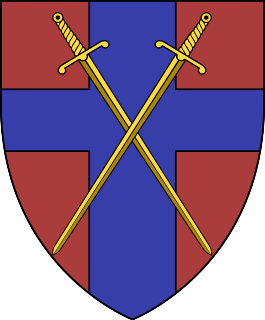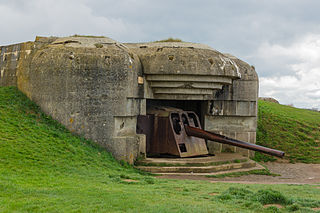
Operation Market Garden was an Allied military operation during the Second World War fought in the Netherlands from 17 to 25 September 1944. Its objective was to create a 64 mi (103 km) salient into German territory with a bridgehead over the River Rhine, creating an Allied invasion route into northern Germany. This was to be achieved by two sub-operations: Seizing nine bridges with combined U.S. and British airborne forces (Market) followed by land forces swiftly following over the bridges (Garden).

The Battle of Arnhem was a battle of the Second World War at the vanguard of the Allied Operation Market Garden. It was fought in and around the Dutch city of Arnhem, the town of Oosterbeek, the villages Wolfheze and Driel and the vicinity from 17 to 26 September 1944. The Allies were poised to enter the Netherlands after sweeping through France and Belgium in the summer of 1944, after the Battle of Normandy. Operation Market Garden was proposed by Field Marshal Sir Bernard Montgomery, who favoured a single push northwards over the branches of the Lower Rhine River, allowing the British Second Army to bypass the Siegfried Line and attack the Ruhr. US Airborne troops were dropped in the Netherlands to secure bridges and towns along the line of the Allied advance. Farthest north, the British 1st Airborne Division landed at Arnhem to capture bridges across the Nederrijn, supported by men of the Glider Pilot Regiment and the 1st Polish Parachute Brigade. The British XXX Corps were expected to reach the British airborne forces in two to three days.

The Normandy landings were the landing operations and associated airborne operations on Tuesday, 6 June 1944 of the Allied invasion of Normandy in Operation Overlord during World War II. Codenamed Operation Neptune and often referred to as D-Day, it was the largest seaborne invasion in history. The operation began the liberation of France and laid the foundations of the Allied victory on the Western Front.

The 21st Army Group was a British headquarters formation formed during the Second World War. It controlled two field armies and other supporting units, consisting primarily of the British Second Army and the First Canadian Army. Established in London during July 1943, under the command of Supreme Headquarters Allied Expeditionary Force (SHAEF), it was assigned to Operation Overlord, the Western Allied invasion of Europe, and was an important Allied force in the European Theatre. At various times during its existence, the 21st Army Group had additional British, Canadian, American and Polish field armies or corps attached to it. The 21st Army Group operated in Northern France, Luxembourg, Belgium, the Netherlands and Germany from June 1944 until August 1945, when it was renamed the British Army of the Rhine (BAOR).

Bény-sur-Mer is a commune in the Calvados department (14) in the Normandy region, la Basse-Normandie, in northwestern France, 4.7 km from Bernières-sur-Mer and 5.2 km from Saint-Aubin-sur-Mer. Bény-sur-Mer was liberated on D-Day by Le Régiment de la Chaudière, a French Canadian unit. There was a gun battery located near the town at the time. The locals were surprised to have been liberated by fellow francophones, expecting only English-speaking troops.

The Normandy American Cemetery and Memorial is a World War II cemetery and memorial in Colleville-sur-Mer, Normandy, France, that honors American troops who died in Europe during World War II. It is located on the site of the former temporary battlefield cemetery of Saint Laurent, covers 172.5 acres and contains 9,388 burials.

Overloon is a village with 3,626 inhabitants on the outskirts of the Peel region, in the former municipality of Boxmeer, North Brabant. Since 2022 it has been part of the new municipality of Land van Cuijk.

Groesbeek Canadian War Cemetery and Memorial is a Second World War Commonwealth War Graves Commission military war grave cemetery, located in the village of Groesbeek, 8 km (5.0 mi) southeast of Nijmegen in the Netherlands. Of the total 2,619 burials, the cemetery contains 2,338 Canadian soldiers. It was built to a design by Commission architect Philip Hepworth.

The Battle of Overloon was a battle fought in the Second World War battle between Allied forces and the German Army which took place in and around the village of Overloon in the south-east of the Netherlands between 30 September and 18 October 1944. The battle, which resulted in an Allied victory, ensued after the Allies launched Operation Aintree. The Allies went on to liberate the town of Venray.

The Bény-sur-Mer Canadian War Cemetery is a cemetery containing predominantly Canadian soldiers killed during the early stages of the Battle of Normandy in the Second World War. It is located in and named after Bény-sur-Mer in the Calvados department, near Caen in lower Normandy. As is typical of war cemeteries in France, the grounds are beautifully landscaped and immaculately kept. Contained within the cemetery is a Cross of Sacrifice, a piece of architecture typical of memorials designed by the Commonwealth War Graves Commission.

Orglandes War Cemetery is a German World War II cemetery in Normandy, France. It is located on the northern edge of the village of Orglandes, about 30 km (19 mi) south east of Cherbourg and 7 km (4.3 mi) west of Sainte-Mère-Église on the Cotentin Peninsula. The burials come from summer 1944, immediately following D-Day and the Battle of Normandy. It is the second smallest of the six German war cemeteries in Normandy with a little over 10,000 burials. The cemetery is maintained and managed by the voluntary German War Graves Commission.

The Longues-sur-Mer battery was a World War II German artillery battery constructed near the French village of Longues-sur-Mer in Normandy. The battery was sited on a 60 m (200 ft) cliff overlooking the sea and formed a part of Germany's Atlantic Wall coastal fortifications. It was located between the Allied landing beaches of Gold and Omaha and shelled both beaches on D-Day. The battery was captured on June 7 and played no further part in the Normandy campaign.

The Arnhem Oosterbeek War Cemetery, more commonly known as the Airborne Cemetery, is a Commonwealth War Graves Commission cemetery in Oosterbeek, near Arnhem, the Netherlands. It was established in 1945 and is home to 1764 graves from the Second World War besides 4 later non-war graves and there are special memorials of two personnel buried elsewhere. Most of the men buried in the cemetery were Allied servicemen killed in the Battle of Arnhem, an Allied attempt to cross the Rhine in 1944, or in the liberation of the city the following year. Men killed in these battles are still discovered in the surrounding area even in the 21st century, and so the number of people interred in the cemetery continues to grow.
During World War II, the Netherlands was the scene of heavy fighting during the Allied advance in the south of the country in 1944–45. Thousands of soldiers and others of many nations were killed, and their war graves in various locations are in the care of the Dutch War Cemetery Organisation.

Al Murray's Road to Berlin is a British documentary television series about World War II, presented by Al Murray. The ten episode series was produced for the Discovery Channel, and first broadcast in 2004. During the series, Murray travels across the Western Front in a restored Willys MB Jeep, covering the timeline from the Invasion of Normandy to the fall of Berlin, interviewing survivors and showcasing some of the equipment used.

Champigny-Saint-André is a German World War II cemetery in Normandy, France. It is located 5 kilometers South of the village of Saint-André-de-l'Eure, about 25 km (16 mi) south east of Évreux. The burials come from the summer of 1944, as the Allies pushed out of Normandy towards Paris. It is the second largest of the six German war cemeteries in Normandy with a nearly 20,000 burials. The cemetery is maintained and managed by the voluntary German War Graves Commission.

The Battle of Nijmegen or Liberation of Nijmegen occurred in the Netherlands from 17 to 20 September 1944, as part of Operation Market Garden during World War II.
The British Normandy Memorial is a war memorial near the village of Ver-sur-Mer in Normandy, France. It was unveiled on 6 June 2021, the 77th anniversary of D-Day, and it is dedicated to soldiers who died under British command during the Normandy landings.




































